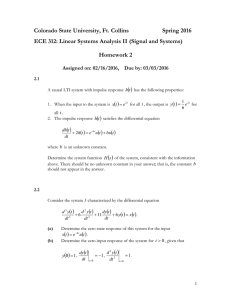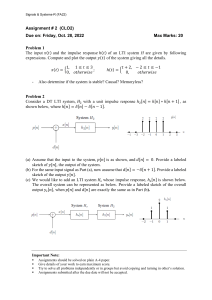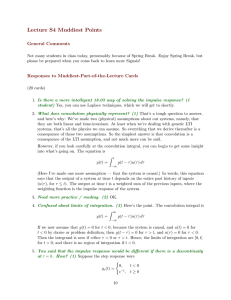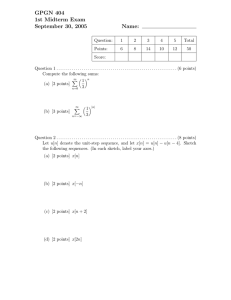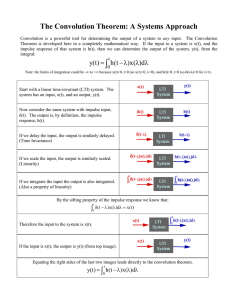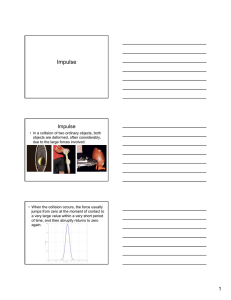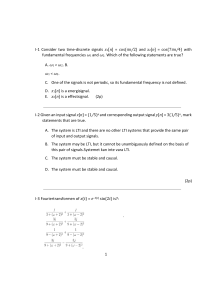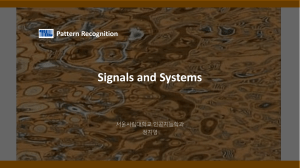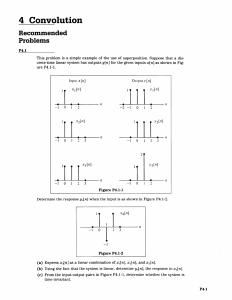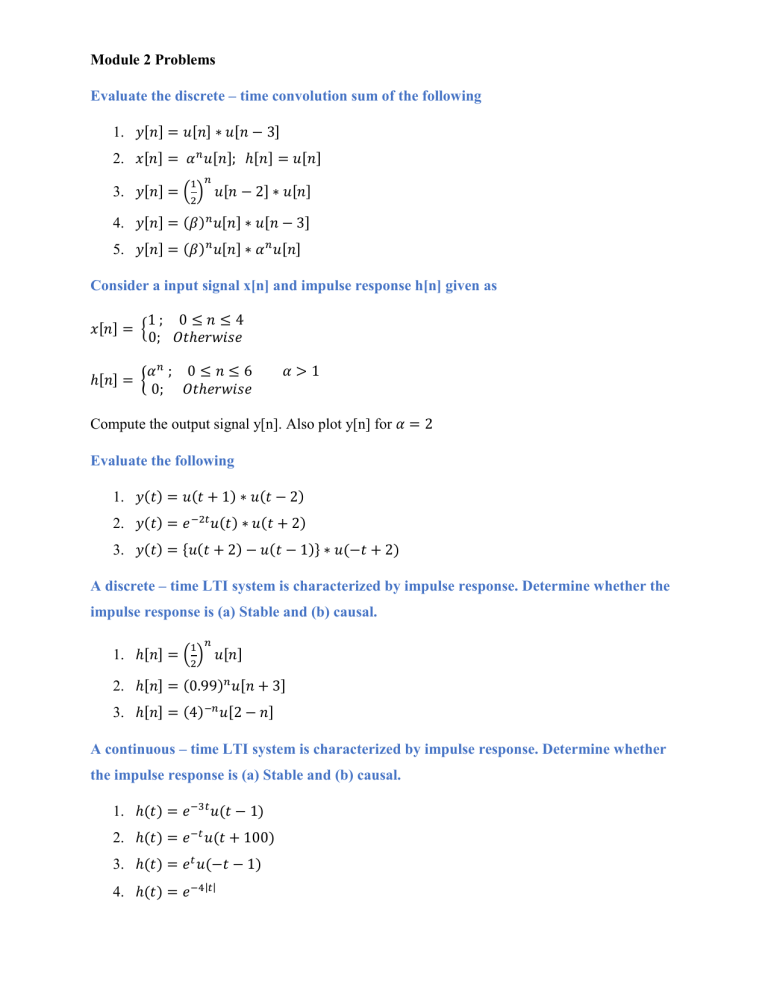
Module 2 Problems
Evaluate the discrete – time convolution sum of the following
1. 𝑦[𝑛] = 𝑢[𝑛] ∗ 𝑢[𝑛 − 3]
2. 𝑥[𝑛] = 𝛼 𝑛 𝑢[𝑛]; ℎ[𝑛] = 𝑢[𝑛]
1 𝑛
3. 𝑦[𝑛] = (2) 𝑢[𝑛 − 2] ∗ 𝑢[𝑛]
4. 𝑦[𝑛] = (𝛽)𝑛 𝑢[𝑛] ∗ 𝑢[𝑛 − 3]
5. 𝑦[𝑛] = (𝛽)𝑛 𝑢[𝑛] ∗ 𝛼 𝑛 𝑢[𝑛]
Consider a input signal x[n] and impulse response h[n] given as
1; 0≤𝑛 ≤ 4
𝑥[𝑛] = {
0; 𝑂𝑡ℎ𝑒𝑟𝑤𝑖𝑠𝑒
𝛼𝑛 ; 0 ≤ 𝑛 ≤ 6
ℎ[𝑛] = {
0; 𝑂𝑡ℎ𝑒𝑟𝑤𝑖𝑠𝑒
𝛼>1
Compute the output signal y[n]. Also plot y[n] for 𝛼 = 2
Evaluate the following
1. 𝑦(𝑡) = 𝑢(𝑡 + 1) ∗ 𝑢(𝑡 − 2)
2. 𝑦(𝑡) = 𝑒 −2𝑡 𝑢(𝑡) ∗ 𝑢(𝑡 + 2)
3. 𝑦(𝑡) = {𝑢(𝑡 + 2) − 𝑢(𝑡 − 1)} ∗ 𝑢(−𝑡 + 2)
A discrete – time LTI system is characterized by impulse response. Determine whether the
impulse response is (a) Stable and (b) causal.
1 𝑛
1. ℎ[𝑛] = (2) 𝑢[𝑛]
2. ℎ[𝑛] = (0.99)𝑛 𝑢[𝑛 + 3]
3. ℎ[𝑛] = (4)−𝑛 𝑢[2 − 𝑛]
A continuous – time LTI system is characterized by impulse response. Determine whether
the impulse response is (a) Stable and (b) causal.
1. ℎ(𝑡) = 𝑒 −3𝑡 𝑢(𝑡 − 1)
2. ℎ(𝑡) = 𝑒 −𝑡 𝑢(𝑡 + 100)
3. ℎ(𝑡) = 𝑒 𝑡 𝑢(−𝑡 − 1)
4. ℎ(𝑡) = 𝑒 −4|𝑡|
Find the step response for the LTI system represented by the impulse response
1 𝑛
1. ℎ[𝑛] = (2) 𝑢[𝑛]
2. ℎ(𝑡) = 𝑡 𝑢(𝑡)
3. ℎ(𝑡) = 𝑒 −|𝑡|
4. ℎ(𝑡) = 𝛿(𝑡) − 𝛿(𝑡 − 1)
Determine convolution of the two given sequences
1. 𝑥[𝑛] = {1, ⏟
2 , 3, 4} 𝑎𝑛𝑑 ℎ[𝑛] = {1
⏟ , 1, 3, 2}
2. 𝑥[𝑛] = {1
⏟ , 2, 4} 𝑎𝑛𝑑 ℎ[𝑛] = {1
⏟ , 1, 1, 1, 1, 1}
Sketch the direct form I and direct form II implementations for the following
1
1. 𝑦[𝑛] + 2 𝑦[𝑛 − 1] − 𝑦[𝑛 − 3] = 3𝑥[𝑛 − 1] + 2𝑥[𝑛 − 2]
1
1
1
2. 𝑦[𝑛] − 4 𝑦[𝑛 − 1] + 8 𝑦[𝑛 − 2] = 𝑥[𝑛] + 2 𝑥[𝑛 − 2]
3.
𝑑 3 𝑦(𝑡)
𝑑𝑡
+2
𝑑 2 𝑦(𝑡)
𝑑𝑡
+ 3𝑦(𝑡) = 𝑥(𝑡) + 3
𝑑𝑥(𝑡)
𝑑𝑡
Solve the following homogeneous differential and difference equations with the specified
initial conditions.
1.
2.
3.
𝑑 2 𝑦(𝑡)
𝑑𝑡
𝑑 2 𝑦(𝑡)
𝑑𝑡
𝑑 3 𝑦(𝑡)
𝑑𝑡
+3
𝑑𝑦(𝑡)
+2
𝑑𝑦(𝑡)
+
𝑑𝑡
𝑑𝑡
𝑑 2 𝑦(𝑡)
𝑑𝑡
+ 2𝑦(𝑡) = 0
+ 𝑦(𝑡) = 0
−
𝑑𝑦(𝑡)
𝑑𝑡
;
;
𝑦(0) = 0 ;
𝑦(0) = 1 ;
𝑦 ′ (0) = 2
𝑦 ′ (0) = 1
− 𝑦(𝑡) = 0 ; 𝑦(0) = 1 ; 𝑦 ′ (0) = 1; 𝑦 ′′ (0) = −2
4. 𝑦[𝑛] − 3𝑦[𝑛 − 1] − 4𝑦[𝑛 − 2] = 0
